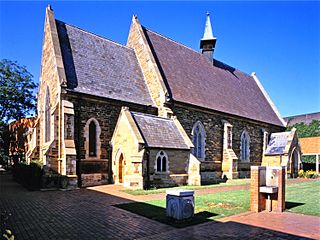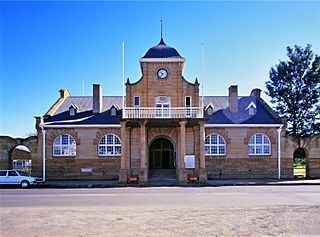
The Province of Natal, commonly called Natal, was a province of South Africa from May 1910 until May 1994. Its capital was Pietermaritzburg. During this period rural areas inhabited by the black African population of Natal were organized into the bantustan of KwaZulu, which was progressively separated from the province, becoming partially autonomous in 1981. Of the white population, the majority were English-speaking people of British descent, causing Natal to become the only province to vote "No" to the creation of a republic in the referendum of 1960, due to very strong monarchist, pro-British Commonwealth, and anti-secessionist sentiment. In the latter part of the 1980s, Natal was in a state of violence between the Inkatha Freedom Party and the African National Congress, with violence subsiding soon after the first non-racial election in 1994.

KwaZulu-Natal is a province of South Africa that was created in 1994 when the Zulu bantustan of KwaZulu and Natal Province were merged. It is located in the southeast of the country, with a long shoreline on the Indian Ocean and sharing borders with three other provinces and the countries of Mozambique, Eswatini and Lesotho. Its capital is Pietermaritzburg, and its largest city is Durban. It is the second-most populous province in South Africa, with slightly fewer residents than Gauteng.

Pietermaritzburg is the capital and second-largest city in the province of KwaZulu-Natal, South Africa. It was founded in 1838 and is currently governed by the Msunduzi Local Municipality. Its Zulu name umGungundlovu is the name used for the Umgungundlovu District Municipality. Pietermaritzburg is popularly called Maritzburg in Afrikaans, English and Zulu alike, and often informally abbreviated to PMB. It is a regionally important industrial hub, producing aluminium, timber and dairy products, as well as the main economic hub of Umgungundlovu District Municipality. The public sector is a major employer in the city due to local, district and provincial government offices located here.

Goodwill Zwelithini kaBhekuzulu was the King of the Zulu nation from 1968 to his death in 2021.

Estcourt is a town in the uThukela District of KwaZulu-Natal Province, South Africa. The main economic activity is farming with large bacon and processed food factories situated around the town. The N3 freeway passes close to the town, linking it to the rest of South Africa.
Howick is a town located in the UMngeni Local Municipality of KwaZulu-Natal Province, South Africa. The town is 1050 m above sea level, and about 88 kilometres from the port city of Durban. It experiences warm summers and cool, dry winters. A snappy chill descends upon Howick when snow falls on the nearby Drakensberg. The town is located on the N3 freeway, connecting it with the rest of South Africa.

Utrecht is a town in the foothills of the Balele Mountains, in the northwestern corner of KwaZulu-Natal, South Africa. Newcastle, Kwazulu-Natal's third-largest urban centre, is 50 km from Utrecht. Utrecht has a population of approximately 32,000.
Pinetown is a city that forms part of the eThekwini Metropolitan Municipality, based just inland from Durban in KwaZulu-Natal, South Africa. The town is situated 16 km north-west of Durban and 64 km south-east of Pietermaritzburg.
Westville is an area in KwaZulu-Natal, South Africa, and is just west and 10 km inland from the Durban CBD. It was a formerly independent municipality however it became part of the eThekwini Metropolitan Municipality in 2002.
Illovo is a suburb of Sandton, South Africa. It borders Hyde Park, Sandhurst, Inanda and Melrose. Illovo is sought-after and home to many young professionals and creatives because of its close proximity to Sandton and Johannesburg business centres and many affordable apartment blocks. It is located in Region E of the City of Johannesburg Metropolitan Municipality.

Pieter Mauritz Retief was a Voortrekker leader. Settling in 1814 in the frontier region of the Cape Colony, he later assumed command of punitive expeditions during the sixth Xhosa War. He became a spokesperson for the frontier farmers who voiced their discontent, and wrote the Voortrekkers' declaration at their departure from the colony.

The KwaZulu-Natal midlands is an inland area of KwaZulu-Natal, South Africa that starts from Pietermaritzburg and ends before the Drakensberg mountain range.

The Diocese of Natal is in the region of Natal, South Africa, the diocese has its northern boundary at the Tugela River. The episcopal leader of the diocese is the bishop of Natal.

The Colony of Natal was a British colony in south-eastern Africa. It was proclaimed a British colony on 4 May 1843 after the British government had annexed the Boer Republic of Natalia, and on 31 May 1910 combined with three other colonies to form the Union of South Africa, as one of its provinces. It is now the KwaZulu-Natal province of South Africa.
The term Byrne Settler refers to any emigrant brought to Natal by the company, J. C. Byrne & Co. These people landed in Natal on 20 ships during the years 1849 to 1851. Allotments were laid out in the Byrne valley, near Richmond.
Dalton is a village in 11 kilometres (6.8 mi) east of New Hanover and 35 kilometres (22 mi) south of Greytown in the uMshwati Local Municipality of KwaZulu-Natal, South Africa
Impendle is a town in Umgungundlovu District Municipality in the KwaZulu-Natal province of South Africa.
Illovo is a town in EThekwini in the KwaZulu-Natal province of South Africa.
The following is a timeline of the history of Pietermaritzburg. It is part of the Msunduzi Local Municipality in the Umgungundlovu District Municipality, KwaZulu-Natal province, South Africa.
Thembeka Vuyisile Buyisile Mchunu is a South African politician from KwaZulu-Natal serving as a Member of the National Assembly of South Africa since 2019. A member of the African National Congress, she served as the Executive Mayor of the Uthungulu District Municipality from 2011 to 2016. She is married to Senzo Mchunu, the current Minister of Water and Sanitation and the former premier of KwaZulu-Natal.












